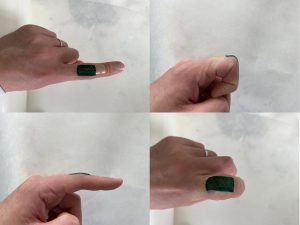Smart ‘E-Skin’ Identifies Your Movements
Technion scientists have created a wearable motion sensor capable of identifying bending and twisting, and can be applied in healthcare and manufacturing
Technion scientists have created a wearable motion sensor capable of identifying movements such as bending and twisting. This smart ‘e-skin’ was produced using a highly stretchable electronic material, which essentially forms an electronic skin capable of recognizing the range of movement human joints normally make, with up to half a degree precision.
This breakthrough is the result of collaborative work between researchers from different fields in the Laboratory for Nanomaterial-Based Devices, headed by Professor Hossam Haick from the Technion Wolfson Faculty of Chemical Engineering. It was recently published in Advanced Materials and was featured on the journal’s cover.
“This sensor has many possible applications,” Prof. Haick stated. “It can be used in early disease diagnosis, alerting of breathing alterations, and motor system disorders such as Parkinson’s disease. It can be used to assist patients’ motor recovery and be integrated into prosthetic limbs. In robotics, the feedback it provides is crucial for precise motion. In industrial uses, such sensors are necessary in monitoring systems, putting them at the core of the fourth industrial revolution.”
Prof. Haick’s lab is focused on wearable devices for various uses. Currently existing wearable motion sensors can recognize bending movement, but not twisting. Existing twisting sensors, on the other hand, are large and cumbersome. This problem was overcome by Ph.D. candidate Yehu David Horev and postdoctoral fellow Dr. Arnab Maity. Horev found a way to form a composite material that was both conductive (and thus, usable as a sensor) and flexible, stretchable, breathable, and biocompatible, and that did not change its electrical properties when stretched. Dr. Maity then solved the mathematics of analyzing the received signal, creating an algorithm capable of mapping bending and twisting motion – the nature of the movement, its speed, and its angle. The novel sensor is breathable, durable, and lightweight, allowing it to be worn on the human body for prolonged periods.
“Electrically conductive polymers are usually quite brittle,” said Yehu about the challenge the group had overcome. “To solve this, we created a composite material that is a little like fabric: the individual polymer ‘threads’ cannot withstand the strain on the material, but their movement relative to each other lets it stretch without breaking. It is not too different from what lends stretch to t-shirts. This allows the conductive polymer withstand extreme mechanical conditions without losing its electrical properties.”
“We want the technological advances we achieve to benefit everyone, regardless of their geographic location and socioeconomic status”
What makes this achievement more important is that the materials the group used are very cheap, resulting in an inexpensive sensor. “If we make a device that is very expensive, only a small number of institutions in the Western World can afford to use it. We want the technological advances we achieve to benefit everyone, regardless of their geographic location and socioeconomic status,” said Prof. Haick. True to his word, among the laboratory’s other projects is a tuberculosis-diagnosing sticker patch, sorely needed in developing countries.
The scientists who contributed to this study are Yehu David Horev, Dr. Arnab Maity, Dr. Youbin Zheng, Yana Milyutin, Dr. Muhammad Khatib, Dr. Ning Tang, and Prof. Hossam Haick from the Department of Chemical Engineering and Russell Berrie Nanotechnology Institute at the Technion-Israel Institute of Technology; Miaomiao Yuan from the Eighth Affiliated Hospital, Sun Yat-sen University, China; Dr. Ran Yosef Suckeveriene from the Department of Water Industry Engineering at the Kinneret Academic College; and Prof. Weiwei Wu from the School of Advanced Materials and Nanotechnology at Xidian University, China.




